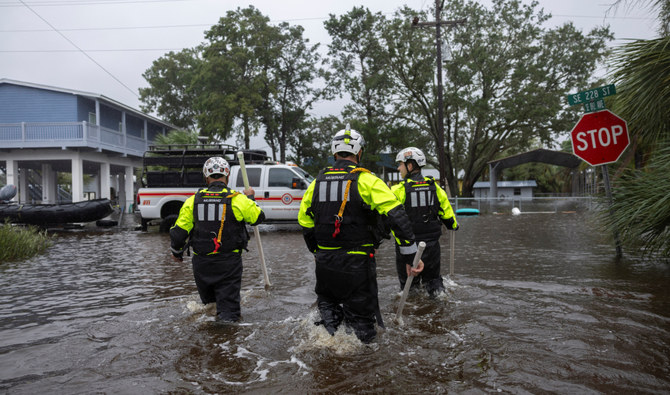MIAMI: At least four people were killed as Tropical Storm Debby drenched Florida on Monday, threatening southeastern US states with heavy rainfall and catastrophic flooding.
A 13-year-old boy died when a tree was blown onto a mobile home in Levy County, the sheriff’s office there said, after Debby made landfall on Florida’s Gulf Coast earlier Monday as a Category One hurricane.
Authorities said a truck driver was killed after his 18-wheeler plunged into a canal in Hillsborough County, while a 38-year-old woman and 12-year-old boy died in a car crash in Dixie County.
The storm is expected to move into Georgia overnight, before moving offshore and approaching the South Carolina coast on Thursday, according to the National Hurricane Center (NHC).
“This is a level four out of four risk for excessive rainfall,” Michael Brennan, director of the NHC, told reporters.
“This is going to result in a prolonged extreme rainfall event with potential for catastrophic flooding across coastal portions of Georgia, South Carolina, even extending up into North Carolina,” he added.
Florida Governor Ron DeSantis said that some 250,000 residents in his state were without power.
“Please, be very cautious when you’re going out,” he said, adding that Debby’s winds had not been as damaging as previous hurricanes that have hit Florida.
President Joe Biden on Sunday approved an emergency declaration for Florida, allowing federal aid to be expedited.
DeSantis has activated the state’s National Guard, with more than 3,000 service members mobilized to help with storm response.
By late afternoon, the NHC said the storm was registering maximum sustained winds of 50 mph (85 kph) as it swept over Florida.
Storm surge warnings — signalling a life-threatening inundation from rising water — are in effect in parts of Georgia, South Carolina and North Carolina.
Debby was expected to bring “potentially historic rainfall” of up to 30 inches as it moved north, the NHC said.
But it said Debby was weakening after making landfall earlier with sustained speeds of 80 mph (130 kph) as a Category One hurricane — the lowest on a scale of five.
Mandatory evacuations were ordered for part of Citrus County, Florida, with eight other counties under voluntary evacuation orders, local media reported.
Police in the city of Sarasota said that some 500 residents were evacuated from their flooded homes.
The governors of Georgia and South Carolina have declared a state of emergency ahead of the storm’s arrival.
Meanwhile, the US Border Patrol announced that Debby had washed up 25 packages of cocaine to the coast of the Florida Keys, where they were seized.
The intended shipment had a street value of more than $1 million, acting chief patrol Agent Samuel Briggs II said on X.
In July, at least 18 people were killed when the powerful Hurricane Beryl tore through the Caribbean before hitting the southern US states of Texas and Louisiana.
Scientists say climate change likely plays a role in the rapid intensification of storms such as Beryl because there is more energy in a warmer ocean for them to feed on.


























